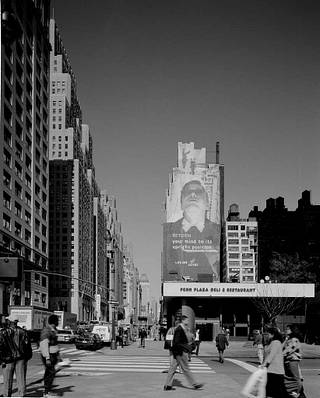
Similar
Street scene showing Acela ad, near Madison Square Garden, New York, New York
Summary
Digital image produced by Carol M. Highsmith to represent her original film transparency; some details may differ between the film and the digital images.
Title, date, and keywords provided by the photographer.
Credit line: Photographs in the Carol M. Highsmith Archive, Library of Congress, Prints and Photographs Division.
Gift and purchase; Carol M. Highsmith; 2011; (DLC/PP-2011:124).
Forms part of the Selects Series in the Carol M. Highsmith Archive.
In 2015, documentary photographer Carol Highsmith received a letter from Getty Images accusing her of copyright infringement for featuring one of her own photographs on her own website. It demanded payment of $120. This was how Highsmith came to learn that stock photo agencies Getty and Alamy had been sending similar threat letters and charging fees to users of her images, which she had donated to the Library of Congress for use by the general public at no charge. In 2016, Highsmith has filed a $1 billion copyright infringement suit against both Alamy and Getty stating “gross misuse” of 18,755 of her photographs. “The defendants [Getty Images] have apparently misappropriated Ms. Highsmith’s generous gift to the American people,” the complaint reads. “[They] are not only unlawfully charging licensing fees … but are falsely and fraudulently holding themselves out as the exclusive copyright owner.” According to the lawsuit, Getty and Alamy, on their websites, have been selling licenses for thousands of Highsmith’s photographs, many without her name attached to them and stamped with “false watermarks.” (more: http://hyperallergic.com/314079/photographer-files-1-billion-suit-against-getty-for-licensing-her-public-domain-images/)
Madison Square is formed by the intersection of 5th Avenue and Broadway at 23rd Street in Manhattan. It was named after James Madison, fourth President of the United States. Two venues called Madison Square Garden were located just northeast of the square, the first from 1879 to 1890, and the second from 1890 to 1925. The first Garden, leased to P. T. Barnum, had no roof and was inconvenient to use during inclement weather, so it was demolished after 11 years. Madison Square Garden II designed by noted architect Stanford White was a Beaux-Arts structure in a Moorish style, including a tower modeled after Giralda, the bell tower of the Cathedral of Seville. Madison Square Garden II was unsuccessful like the first Garden, and the New York Life Insurance Company, which held the mortgage on it, decided to tear it down in 1925 to make way for a new headquarters building, which would become the landmark Cass Gilbert-designed New York Life Building. A third Madison Square Garden opened in a new location, on 8th Avenue between 49th and 50th Streets, from 1925 to 1968. Groundbreaking on the third Madison Square Garden took place on January 9, 1925. The arena was 200 feet (61 m) by 375 feet (114 m), with seating on three levels, and a maximum capacity of 18,496 spectators for boxing. Demolition commenced in 1968 after the opening of the current Garden and was completed in early 1969. The new structure was one of the first of its kind to be built above the platforms of an active railroad station. As of now, Madison Square Garden is seen as an obstacle in the renovation and future expansion of Penn Station.
Tags
Date
Contributors
Location
Source
Copyright info






























